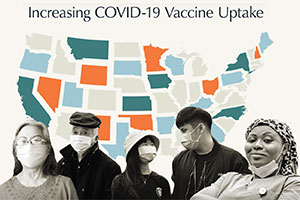COVID-19 Vaccines
The development of safe and effective COVID-19 vaccines is a huge accomplishment. Getting those shots into arms continues to be a pressing public health challenge.
APHA Executive Director Georges Benjamin: "We know that the vaccine for COVID-19 is very safe, and it really works."
What You Need to Know
- GetVaccineAnswers.org (Ad Council and COVID Collaborative)
- COVID-19 Vaccines (CDC)
- COVID-19 Vaccines (FDA)
- Questions and Answers About COVID-19 and COVID-19 Vaccines (Vaccinate Your Family)
- THE CONVERSATION: Between Us, About Us (Kaiser Family Foundation/Black Coalition Against COVID)
- Innovative resources help communicate, educate audiences on COVID-19 vaccines (The Nation's Health)
- COVID-19 Vaccination in the United States (updated CDC data)
FDA authorizes Pfizer COVID-19 vaccine for use in 12-15-year-olds
- For Parents: COVID-19 Vaccines For Children and Teens
- For Pediatric Health Professionals: COVID-19 Vaccination Toolkit
How to Help
 Join the COVID-19 Community Corps. Led by the U.S. Department of Health and Human Services, the effort offers timely, accurate information to share in your community.
Join the COVID-19 Community Corps. Led by the U.S. Department of Health and Human Services, the effort offers timely, accurate information to share in your community.- Share the Rockefeller Foundation's Vaccine Confidence Message Brief, which explores what motivates high-priority groups to get the COVID-19 vaccine and includes message recommendations such as "Frame vaccines as an empowering tool, not an ultimatum."
- Get vaccinated. Help others get vaccinated.
- If you're a health care provider, CDC offers answers to some frequently asked vaccine/vaccination questions.
- Keep following key public health advice (wash your hands, wear a mask, keep your distance) and encourage others to do the same.
Barbershop Medicine Talks to Anthony Fauci

